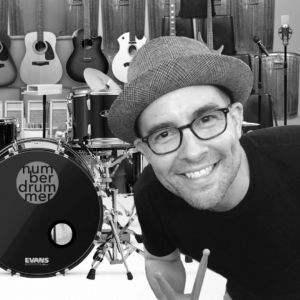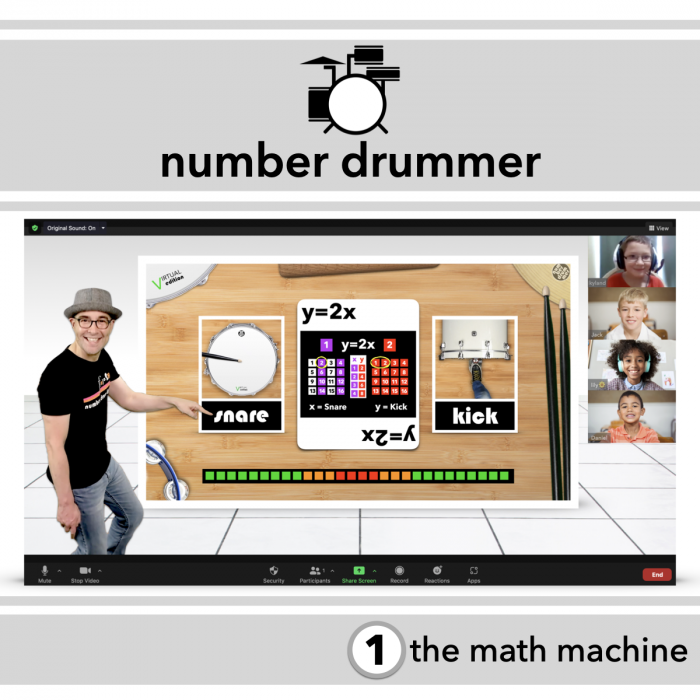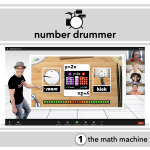Number Drummer

Number Drummer creator, Troy Kryzalka, has worked in music and education for over 20 years. Along with being a musician and classroom teacher, Troy has worked in curriculum and instruction as a trainer, coach, and developer. Number Drummer was created because Troy struggled to learn and understand
…
View moreEducator CONTACT INFO
SELECT A PROGRAM
"The Math Machine" | VIRTUAL EDITION

Program Description
Did you know a drum set is a math machine? Did you know you can drum addition and multiplication? Want to hear what algebra sounds like? Ready to drum up 10 cups and 48 fluid ounces? It is time to see, hear, and feel the sweet sound of math. Using body percussion (snap, pat, clap, stomp), real instruments (drums or keyboards), or other creative materials (sticks, buckets, boxes, etc.), students
...Booking / scheduling contact
Program Detail
Based upon availability
Based upon availability
1) Zoom Meeting/Webinar
2) Simple and available classroom objects and materials – Examples: Chairs, pencils, and table-tops (Contact artist for further details)
Classroom with access to streaming technology (webcam, audio-source, projector, large screen or SMART Board display, etc.) Contact artist for further details.
Single Interactive Session: $595 (K-5)
2 Interactive Sessions (K-2 & 3-5): $795
Single Classroom Workshop: $125
SESSION LENGTH OPTIONS
1 x 45 minute or 2 x mini-sessions (30 min. + 20 min.)
FORMATS
Virtual (Zoom), VOD (Vimeo), or Combination. The combination option provides a 20 – 30 minute pre-recorded video-on-demand session (PART 1), followed by a 20 minute live virtual mini-lesson/Q&A (PART 2)
EDUCATION STANDARDS
North Carolina Standard Course of Study for K-8 Mathematics
During Number Drummer Workshops and Live Interactive Performances, participants experience math content from a variety of standards and at a variety of levels. Listed are the top 6 overall standards followed by a list of specific standards that students kindergarten through 8th grade rhythmically perform and experience through Number Drummer.
Top 6 Math Standards demonstrated through Number Drummer
CC – Counting & Cardinality
OA – Operations and Algebraic Thinking
MD – Measurement & Data
NF – Number and Operations—Fractions
RP – Ratios and Proportions
EE – Expressions & Equations
List of Grade Level Specific Standards from the NC Standard Course of Study for K-8 Mathematics (2018-19)
Kindergarten
Counting and Cardinality NC.K.CC.1-7
Operations and Algebraic Thinking NC.K.OA.1 (Addition using sound)
1st Grade
Measurement & Data NC.1.MD.5 (Money: The rhythmic sound of pennies, nickels and dimes)
Geometry NC.1.G.3 (Intro to fractions through partitions of a rectangle)
2nd Grade
Measurement & Data NC.2.MD.1 (Length related to beat & rhythm)
Measurement & Data NC.2.MD.8 (Money: The rhythmic sound of pennies, nickels and dimes)
Operations and Algebraic Thinking NC.2.OA.3-4 (Repeated Addition; Rectangular Arrays, Odd & Even)
Geometry NC.2.G.3 (Intro to fractions through rows, columns and partitions)
3rd Grade
Operations and Algebraic Thinking NC.3.OA.1 (Rhythm & Beat through Repeated Addition & Arrays)
Operations and Algebraic Thinking NC.3.OA.2 (Rhythm & Beat through Division & Arrays)
Operations and Algebraic Thinking NC.3.OA.7 (Facts and Relationship between Multiplication & Division)
Operations and Algebraic Thinking NC.3.OA.9 (Patterns in a multiplication table or 100s board)
Number and Operations—Fractions NC.3.NF.1-4 (Fractions, Number Lines, Comparisons, Equivalents)
Measurement & Data NC.3.MD.2 (Beat & Rhythm through customary measurement)
4th Grade
Operations and Algebraic Thinking NC.4.OA.4-5 (Factors, Multiples, Patterns)
Number and Operations—Fractions NC.4.NF.1-3 (Simplify, Compare, Equivalents)
5th Grade
Operations and Algebraic Thinking NC.5.OA.3 (Numerical patterns – Input/Output).
Number and Operations—Fractions NC.5.NF.3 (Reinforce & Extend, Multiply & Divide, Mixed, Improper)
Measurement & Data NC.5.MD.1 (Beat & Rhythm through conversions of customary measurement)
6th Grade
Ratios and Proportional Relationships NC.6.RP.1-3 (Rhythm through ratios; Rhythmic tables that demonstrate ratios)
Number System NC.6.NS.3 (Beat & Rhythm demonstrated through the GCF & LCM)
Expressions & Equations NC.6.EE.9 (Rhythmically represent relationships between dependent and independent variables.)
Reinforcement of prior skills (OA, NF)
7th Grade
Ratios and Proportional Relationships NC.7.RP (Rhythmically represent & perform proportional relationships.)
Reinforcement of prior skills (NF, NS, EE)
8th Grade
Expressions & Equations NC.8.EE.2 (Compare two different proportional relationships as two rhythm patterns.)
Functions NC.8.F.4 (Construct a function to model a linear relationship between two quantities.)
Statistics & Probability NC.8.SP.4 (Rhythmically demonstrate a two-way relative frequency table as a proportional
relationship)
Reinforcement of prior skills (NF, NS, RP, EE)
North Carolina English Language Arts Standard Course of Study (K-5)
Top 3 North Carolina English Language Arts Standards
RF – Reading Foundations: Phonological Awareness
RF – Reading Foundations: Phonics and Word Recognition
L – Language: Vocabulary Acquisition and Use
North Carolina English Language Arts Standard Course of Study (K-5)
RF – Reading Foundations
From kindergarten through 5th grade (and even above), phonological awareness is integrated through being able to demonstrate understanding of spoken words, syllables, and sounds (phonemes) (2). Phonics and word recognition requires students to be able to decode and read accurately unfamiliar multisyllabic words (3). The comparison between syllabication and rhythm is used as an illustrative tool to help students hear what certain fractions sound like and to expedite a student’s ability to learn and perform the music in a short period of time.
North Carolina English Language Arts Standard Course of Study (K-8)
L – Vocabulary Acquisition and Use
From kindergarten through 8th grade, students must be able to determine or clarify the meaning of unknown and multiple-meaning words and phrases based on grade level reading and content area vocabulary. Vocabulary exposure and usage is very important within Number Drummer performances, workshops, and sessions because if provides even greater understanding and connectedness between mathematics and music. It also allows the participants to make classroom and real-world connections after their Number Drummer experience.
NC Essential Standards – MUSIC
During a Number Drummer Workshop or Live interactive performance, participants experience a spectrum of musical concepts, but the foundation of Number Drummer is built upon the following musical elements: Beat, Rhythm, Timbre, Dynamics, Tempo, and Form. Most importantly is the interdisciplinary element of Number Drummer, which is the connection between math and music. (K-8 CR.1) Listed are the top 3 standards followed by an expanded list of principal music standards that students (Kindergarten through 8th grade) experience through a Number Drummer Live interactive performance or workshop.
Top 3 Essential Standards for Music
ML.1.3 – Execute rhythmic patterns using body, instruments, or voice.
ML.3.2 – Create compositions & arrangements using a variety of traditional & non-traditional sound sources.
CR.1.2 – Understand the relationships between music and concepts from other areas
Grades K-3.ML.1 Apply the elements of music and musical techniques in order to sing and play music with accuracy and expression.
K.ML.1.3
Execute simple rhythms using body, instruments, or voice.
K.ML.1.5
Illustrate a steady beat.
1.ML.1.3
Execute rhythmic patterns using body, instruments, or voice.
2.ML.1.3
Execute extended rhythmic patterns using body, instruments, or voice.
2.ML.1.4
Apply changes in music to the elements of dynamics, tempo, melody, and form.
3.ML.1.3
Use instruments to perform rhythmic and melodic patterns accurately and independently on classroom rhythmic and melodic instruments.
Grades 4-8.ML.3 Create music using a variety of sound and notational sources.
4.ML.3.2
Create compositions and arrangements using a variety of traditional and non-traditional sound sources.
4.ML.3.3
Create rhythmic compositions which include the use of whole, dotted half, half and quarter notes; whole, half and quarter rests; and beamed eighth notes in duple and triple time and which are arranged using a variety of sound sources.
5.ML.3.3
Create rhythmic compositions using notation for whole, dotted half, half, and quarter notes; whole, half and quarter rests; and beamed eighth notes in duple, triple, and common time and which are arranged using a variety of sound sources.
6.ML.3.2
Construct arrangements of simple pieces for voices or instruments other than those for which the pieces were written.
7.ML.3.2
Construct simple examples of musical styles or forms using a variety of traditional and non-traditional sound, notational, and technological sources.
8.ML.3.2
Construct short pieces within specified guidelines (e.g., a particular style, form, instrumentation, compositional technique), using a variety of traditional and non-traditional sound, notational, and 21st century technological sources.
Grades K-8.CR.1 Understand global, interdisciplinary, and 21st century connections with music.
K-8.CR.1.2
Understand the relationships between music and concepts from other areas (Mathematics).
NC Essential Standards – SCIENCE
During a Number Drummer Workshop or Live interactive performance, participants experience a strong connection to the following science concepts: Sound, Motion, “Reduce, Reuse, Recycle”, and Genetics. The interdisciplinary connection of Number Drummer to genetics is found in the comparison between mathematical and rhythmic patterns to patterns and probability in genetics. Listed are 4 key concepts followed by an expanded list of specific science essential standards (Kindergarten through 8th grade) experienced through Number Drummer Live interactive performances and workshops.
4 Key Concepts for Science (K-2, 3-5, 6-8)
Physical Science – Matter and physical properties of sound (Vibration, dynamics, pitch, timbre, etc.)
Physical Science – Motion in relation to music (Time & Distance compared to Tempo & Duration)
Life Science – Protecting the environment (Reduce, Reuse, Recycle)
Life Science – Genetics (Rhythmic DNA)
Qualifications
References
Available upon request
Cancellation Policy
If either party cannot perform this contract due to fire or other casualty, inclement weather or hazardous conditions, illness or injury, or other cause beyond the control of the parties, then either party reserves the right to cancel and reschedule, but due to travel and scheduling, cancellation by the customer must occur no less than 48 hours prior to the event, otherwise a 20% service fee will be charged. No service fee will be charged if cancellation is COVID related or due to unpredictable weather.



